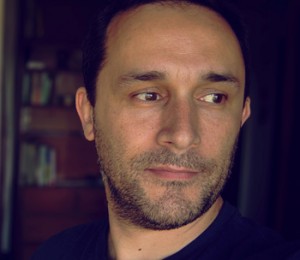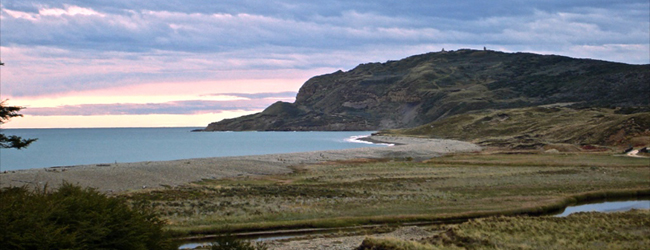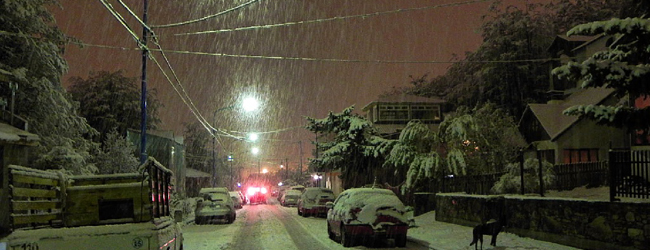Filming in Tierra del Fuego with Location Manager Santiago Pampliega
Santiago studied film in the prestigious Universidad del Cine of Buenos Aires in the 90s. At first he worked in production for commercials and features.
 "Argentinean crews at that time didn’t have a specialised locations department; it was all part of production, so that was my first contact with the job."
"Argentinean crews at that time didn’t have a specialised locations department; it was all part of production, so that was my first contact with the job."
Later he developed an interest in technology and computers, and began working as an editor.
"I’ve done a lot of TV, documentaries and commercials in that role. Two years ago I started my own company - Septiembre Films - to get back into production. Then I discovered that nobody was doing locations in Tierra Del Fuego! Being a place I love and know well, I am putting a lot of effort into developing Tierra Del Fuego as a film-savvy place and positioning it on the map of film locations."
Tell me about your region.
Tierra Del Fuego is a series of islands. The biggest one is called Isla Grande. It’s at the very south of Patagonia; the point where the continent ends. Usually it’s called “the end of the world”; not only because it’s so far south (3,200 km from Buenos Aires!), but also because Ushuaia, the capital of the province, is the door to Antarctica. It’s the last port of call for most ships before heading to the White Continent.
There are amazing skies at sunrise or sunset, double rainbows and a unique sunlight due to the latitude.
A common mistake is that people think Tierra Del Fuego is similar to Antarctica; that is not true.
The island has two very different kinds of landscapes. To the south there are mountains, lakes and dense forests. But there’s also a flat, deserted, steppe-like (grassy) landscape that’s very interesting. Everything gets covered with snow during the winter (the seasons here are reversed from the northern hemisphere).
 The three towns in Tierra Del Fuego have very different looks. Ushuaia is a commercial and residential city right at the feet of the mountains and over the edge of the sea. Rio Grande is more industrial and could pass for other cities on the patagonian steppe. And there’s Tolhuin, a very small village in the heart of Tierra del Fuego, which is a place of great beauty, patagonian style: huge spaces, big scenery, little or no human signs as far as you can see.
The three towns in Tierra Del Fuego have very different looks. Ushuaia is a commercial and residential city right at the feet of the mountains and over the edge of the sea. Rio Grande is more industrial and could pass for other cities on the patagonian steppe. And there’s Tolhuin, a very small village in the heart of Tierra del Fuego, which is a place of great beauty, patagonian style: huge spaces, big scenery, little or no human signs as far as you can see.
Another highlight of the region is its wild nature.
What locations are most commonly used by film and TV crews when they film here?
Traditionally the most used locations were in Ushuaia (the capital of the Tierra Del Fuego province): the old jail (now a museum), the port, the city itself. But in recent years film crews are moving away from the city to where the real beauty and uniqueness of the landscape is.
What are the locations that our readers would not associate with the region?
A common mistake is that people think Tierra Del Fuego is similar to Antarctica; that is not true. Besides the winter snow it has a lot of trees and is very green during the summer. There is an incredible variety of colours in the autumn. There are mountains and lakes, and also plain areas, more like a steppe.
Having knowledgeable people will save you a fair amount of headaches, and money too.
Certain areas of the province look very much like the Malvinas (Falkland) Islands and also a bit like Norway, Sweden or Scotland, but mainly it has its own character and look. The weather is similar to Iceland or the Alaskan peninsula.
Another important thing about Tierra Del Fuego is that it resembles the different looks of Patagonia, but condensed in one small place and with general services much more developed in comparison, thanks to tourism. If you use the little town of Tolhuin as a base, any point on the island is less than 80 km in a straight line, so you’re pretty close to everything.
 What types of production do you work on most?
What types of production do you work on most?
Tierra Del Fuego has hosted many international features including Wong Kar Wai's Happy Together from Hong Kong, Uwe Müller's Gordo’s Trip to the end of the World from Germany and Bernard Boyer's Terre du Feu, Fille du Vent from France.
Is there anything else you would like to share about filming in your region?
If you want to film in Tierra Del Fuego good pre-production is key. Being the remote place it is sometimes services require a bit more effort and time to set up. Distances are longer than you might be used to but visually it’s very rewarding!
The technical and artistic skills of Argentinean crews are well-known worldwide, but if you’re planning to shoot in this far region having knowledgeable people will save you a fair amount of headaches. And money too!
Which are the best airports to use to film in your region?
There’s two airports in Tierra Del Fuego: Ushuaia is the biggest one because it’s a place with very intense touristic activity. The other one is Rio Grande to the north of the island. Most international flights arrive at Buenos Aires so film crews will have to go through the country’s capital before making the connection to Tierra Del Fuego.
What are the most film-crew-friendly hotels in your region?
In Buenos Aires Hotel Madero is very crew-friendly. In Tierra Del Fuego Hostería Kaikén is great, especially because it’s a little hotel and they adapt easily. And then of course Ushuaia is full of good hotels. It all depends on where you are making base.
When you are not location scouting or shooting what do you do when you have time off and what would you recommend film crew and cast to do to relax in your region?
There’s a lot to do in Tierra Del Fuego, especially if you like adventure. Trekking, fishing, skiing; all sorts of outdoor activities. In the city there are a few nice museums about the history of the island. You can also sail the Beagle Channel or visit the gorgeous National Park.
My favourite place though is cabo San Pablo. An absolutely stunning landscape! It's a beach surrounded by high cliffs with a small lighthouse in the top of a hill and a river joining the sea. Condors fly above everything. In the middle of that - totally unexpected - the enormous, rusty structure of a cargo ship that seems to be sailing when the tide is high (pictured above). But it’s wrecked! It’s been there for 25 years and still standing. If you ever come to Tierra Del Fuego, don’t leave without asking me the whole story. The captain is a friend of mine...
Thank you.
Click here to contact Santiago.
Related Posts
- Filming in Argentina with Assistant Director Ginger Gentile
- Filming in Buenos Aires with Location Manager Eugenia D’Alessio
- Filming in South America with Location Manager Mariano Cukar
- International co-production The Games Maker films on location in Buenos Aires
- Buenos Aires Province: Filming on location on a great film set
- Filming on location with the Mexico City Film Commission
- Arts & Sciences films a casual apocalypse on location in a crowded Buenos Aires
- Henry De Czar unleashes a monster as Buenos Aires doubles for France
Related posts:
Comments
Not Logged in
You must be logged in to post a comment








There are 1 comments
Bill Bowling
| #
Gorgeous, interesting vis a vis Swedish lapland...
Reply